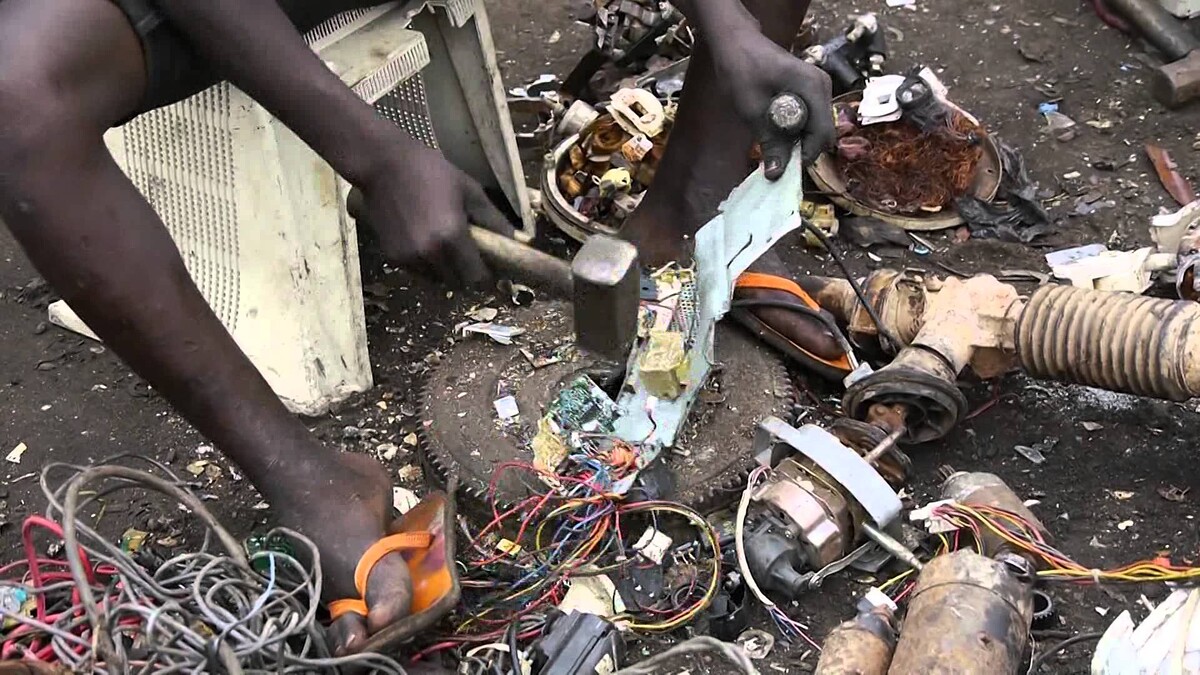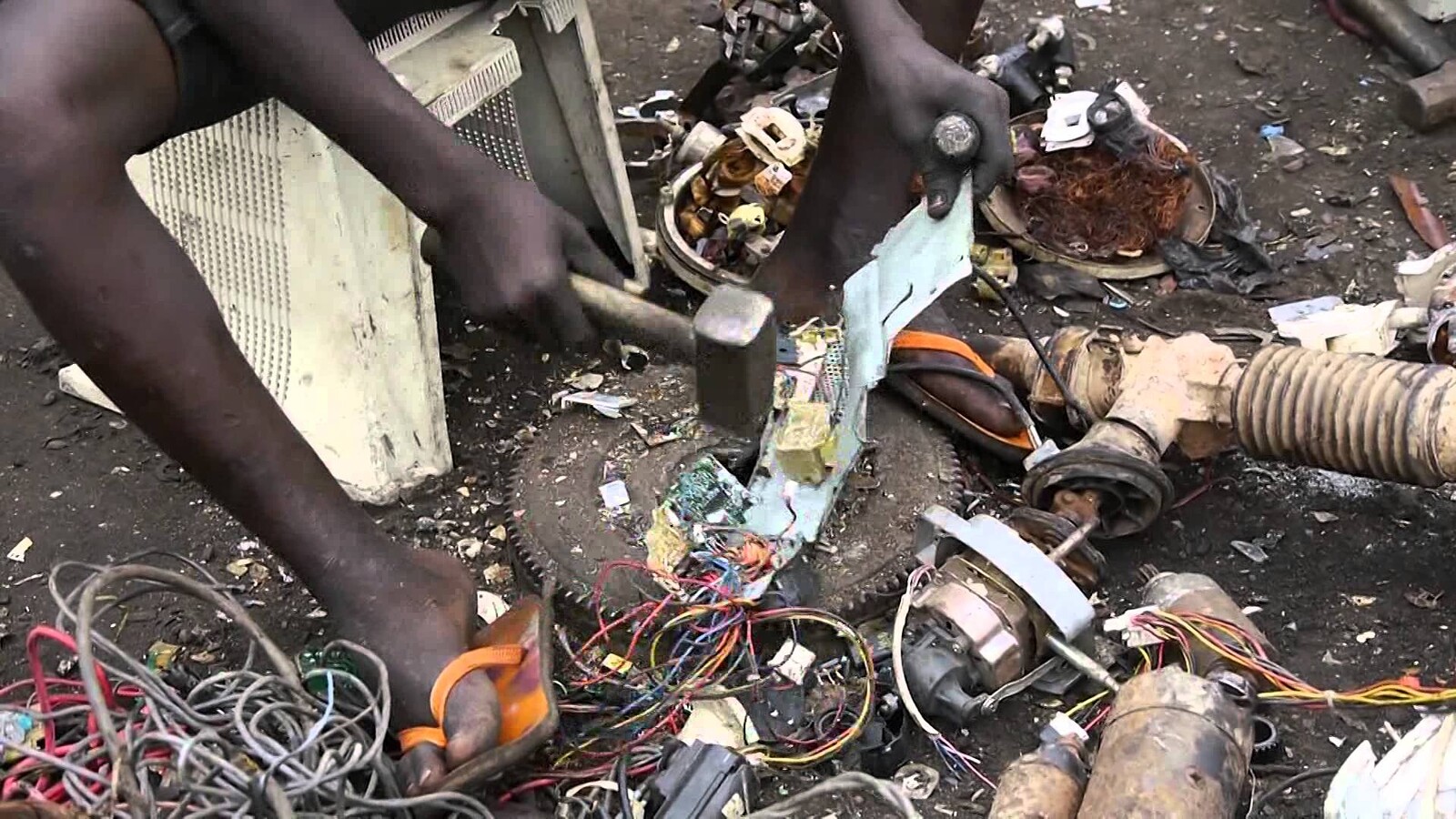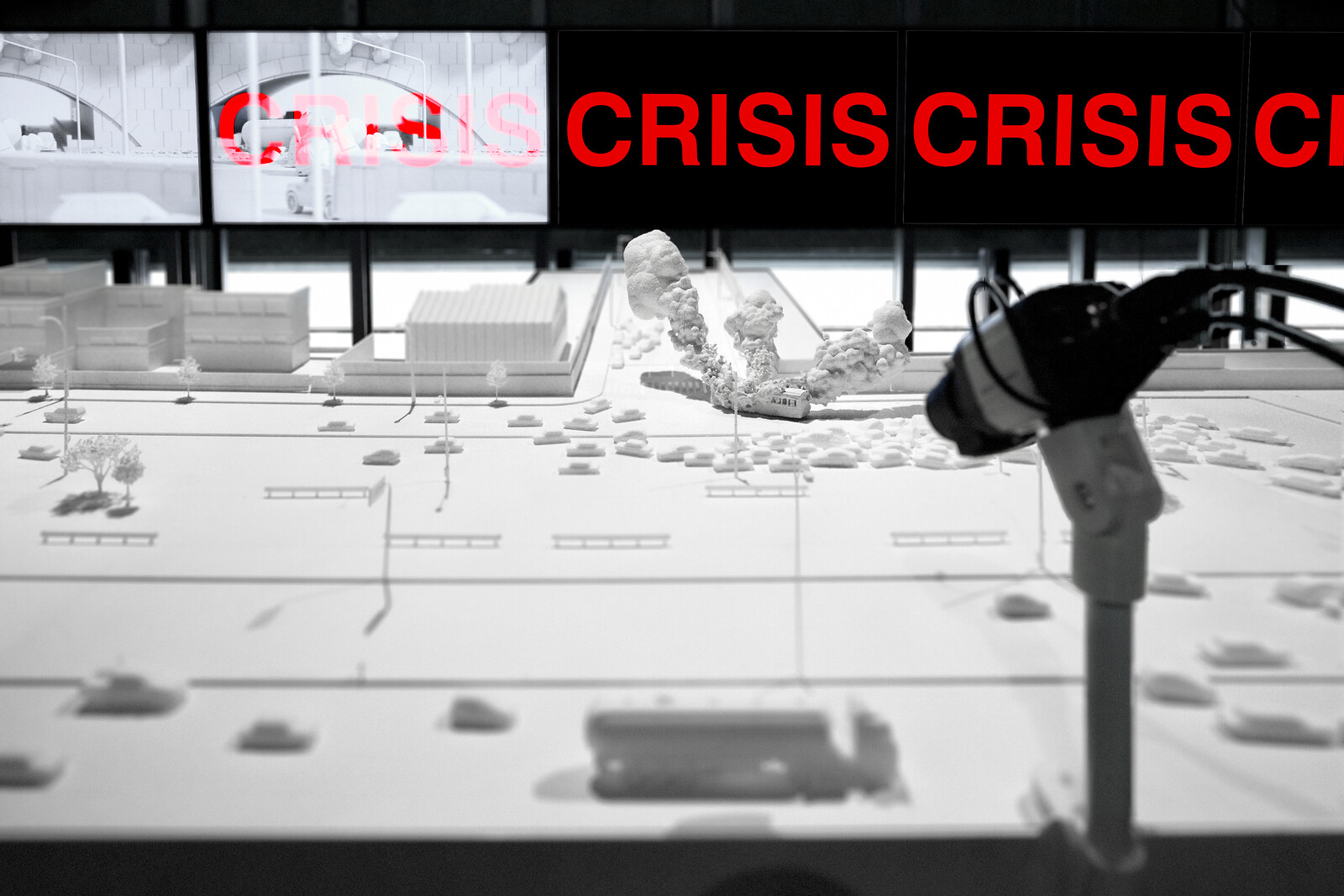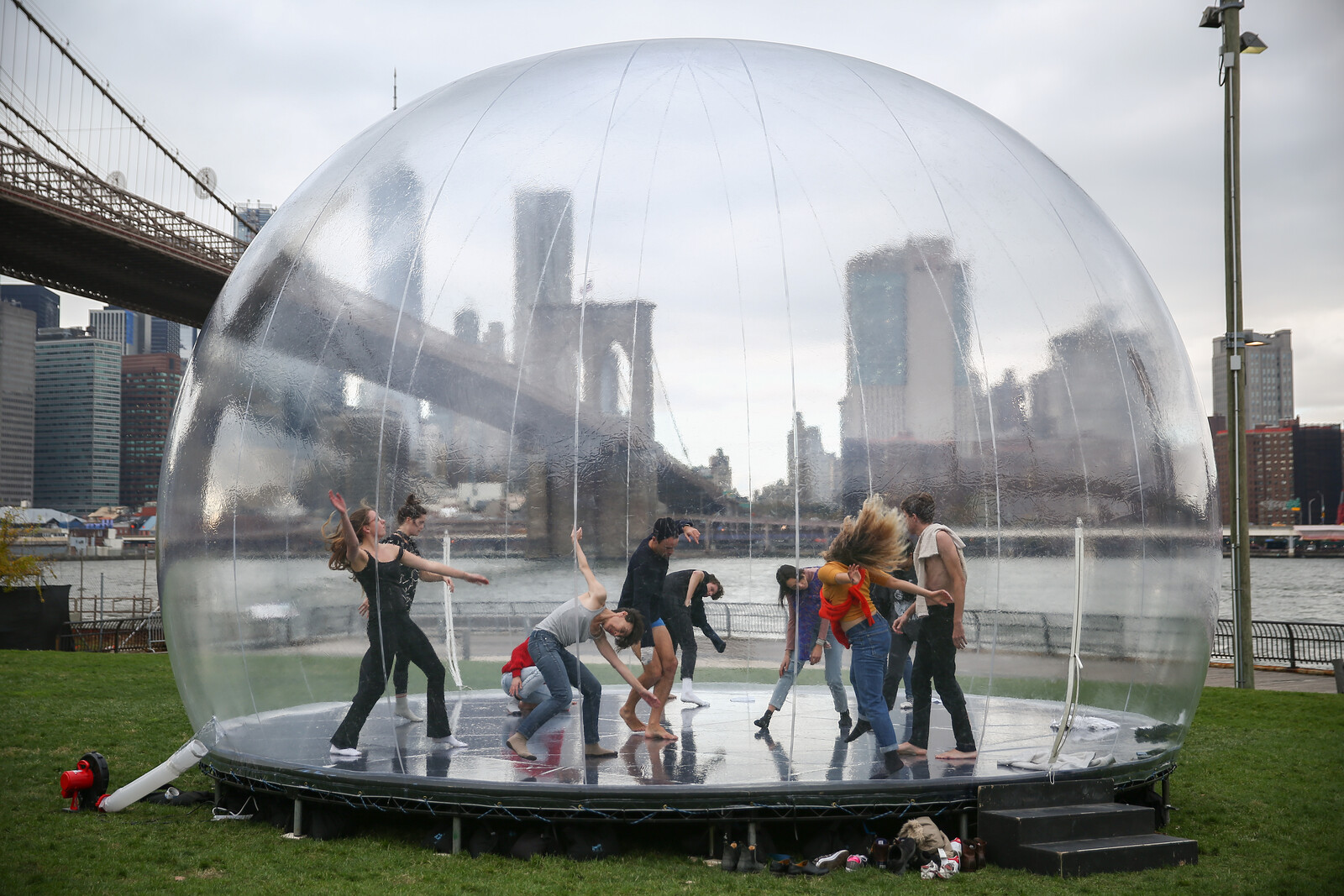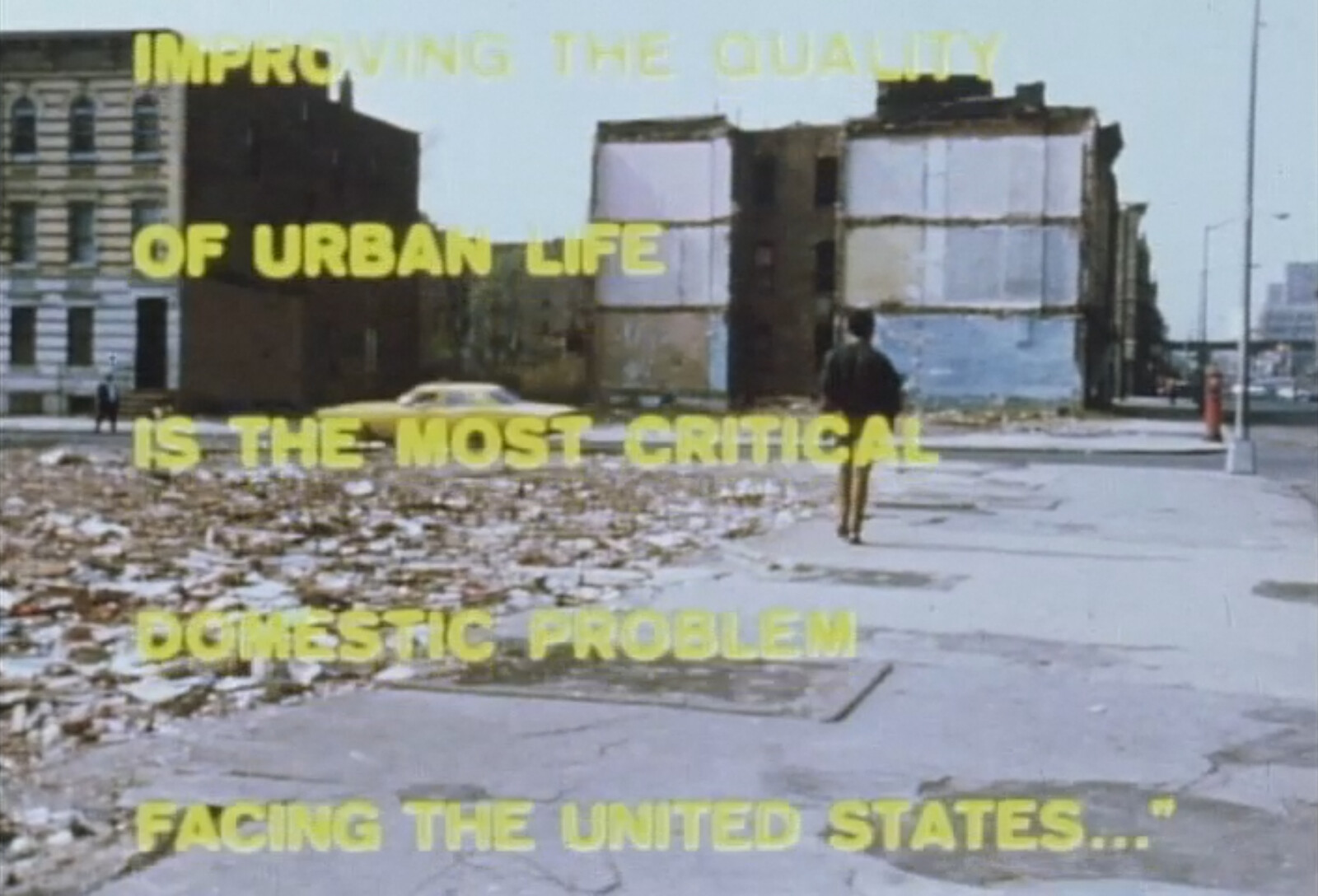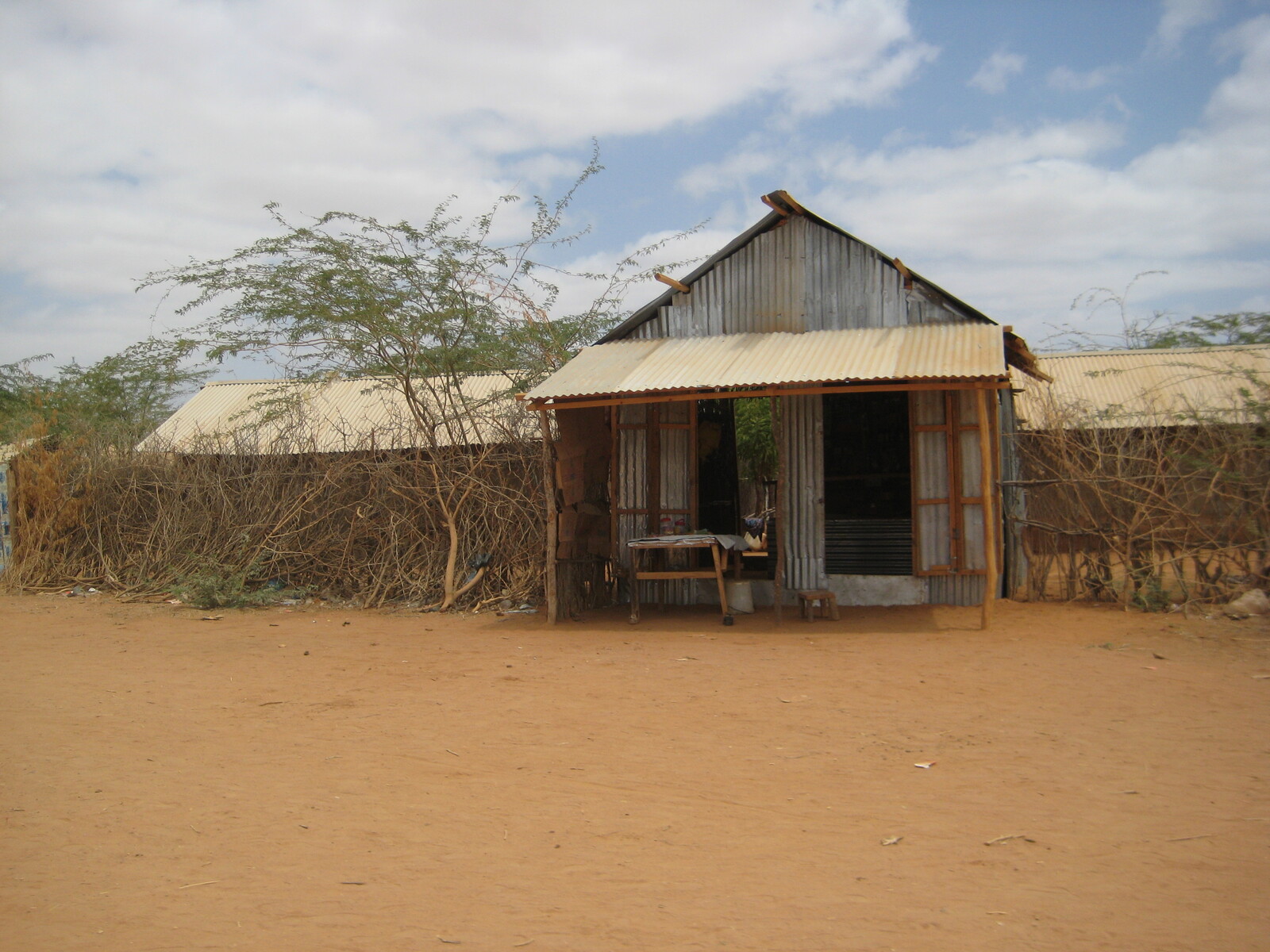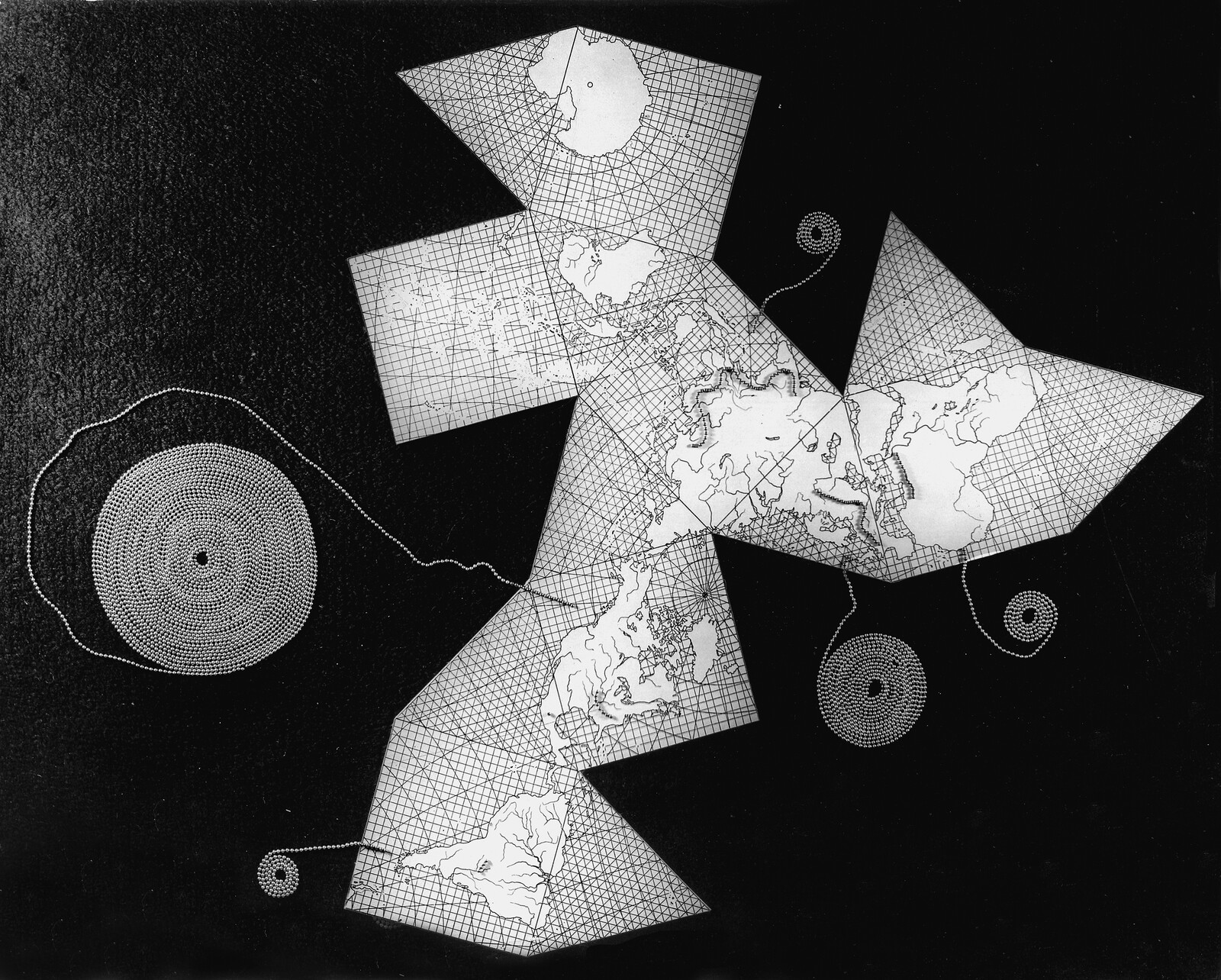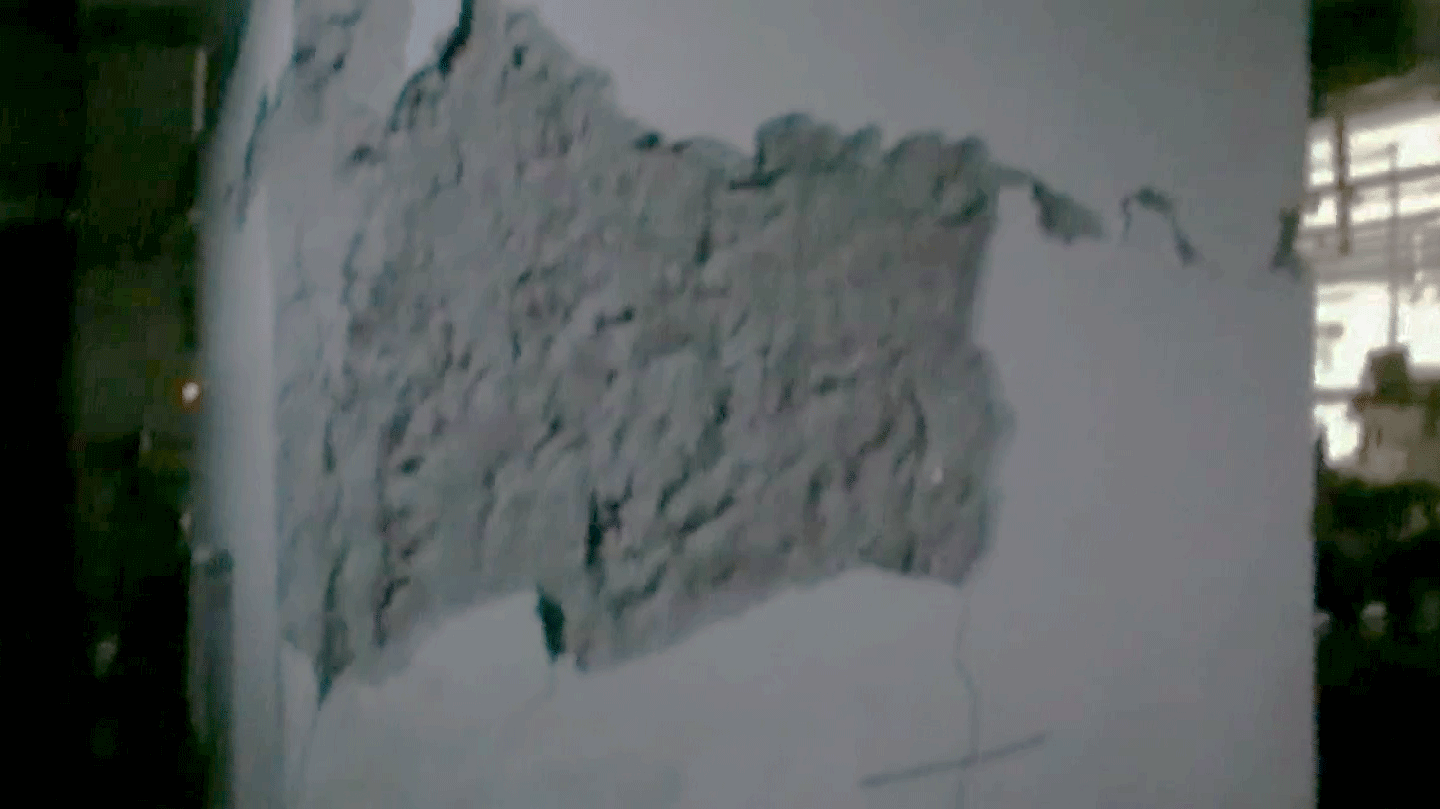I. The Alchemy of Debt
In the early 1980s, architect Yona Friedman and artist Jean-Pierre Giovanelli undertook a project titled une intervention sur le déchet (“an intervention on the scrap”).1 The project entailed a four-phase process: First, during the “Phase of Accumulation,” Friedman and Giovanelli amassed what they described as scrap parts from “our sophisticated technologies.” During the subsequent “Phase of Transformation,” these scraps were distributed among “artisanal populations” in non-specified areas of Africa and there subject to a process of “free transformation.” For the next “Phase of Recuperation,” the altered detritus was shipped back to Europe. And finally, during the “Phase of Reinjection,” the resulting art objects were exhibited and sold at a Parisian gallery, with the financial proceeds remitted to Africa.
The project was executed contemporaneously with debt crises throughout the global south, which hit Africa with particular severity. In the early 1980s, economists warned that financial instability in the global north might follow the south’s epidemic of debt default. Using Zaire as a testing ground, international financial cabals such as the Club of Paris and the Club of London, in conjunction with the International Monetary Fund, proposed new methods of restructuring southern debt, starting with the massive devaluation of Zaire’s currency. In an attempt to rescue the solvency of financial lenders, Structural Adjustment Programs were devised, based largely on such economic experiments. This included the imposition of drastic austerity measures, which put a halt to many of the industrialization and infrastructural projects that had been undertaken by Africa’s postcolonial nations. In this historical context, Friedman and Giovanelli’s project can be seen as an artistic analog to the methods of restructuring debt that were being contemporaneously pioneered throughout Africa and Latin America. As these syndicates sought to render southern debt crises financially viable for northern investors, the intervention suggested a way to stabilize capitalism by tinkering with its underlying conditions of instability.
Taking advantage of the different values that had historically accrued to African versus European creative labor (that is, to African “bricolage” versus European “conceptual art”), Friedman and Giovanelli’s project made this system of economic imbalance serve as the basis of profit. The technological scrap’s transmutation from dross into lucre generated profit not so much by dint of the African artisans’ specific physical transformations but rather by Friedman and Giovanelli’s general conceptualization of the project as a work of art. However, contrary to colonial and neo-colonial tendencies, Friedman and Giovanelli stipulated that the resulting profit would be returned to Africa. In other words, African artisans stood to profit from the legacies of colonialism—from the long-extant racial devaluation that undergirded a global division of labor with its concomitant inequalities. As economic inequality between Africa and Europe was recast as the essential ingredient within an alchemical system, legacies of racism could be turned to Africans’ financial advantage. The longstanding devaluation of African technical labor would be turned to African profit when passed through the alembic of European conceptual art, one that magically transposed the products of mere tinkering into the presumed domain of European apperception.
The necessity of devaluation as a pre-condition for profit appears in Friedman and Giovanelli’s failure to ascribe the value of the resulting objects to a particular body of technical expertise, despite the fact that such knowledge was implicit to the artisans’ ability to transform industrial detritus into art. This devaluation is less the result of the artisans’ personal anonymity than it is the result of the anonymity of the African city, village, nation, or region that was selected for the project. That is, the devaluation significant here is not that of individual creativity but rather of societal modes of transmitting knowledge. We can only guess the likelihood that the “phase of transformation” had been undertaken in a former French colony, perhaps in one of the many West African cities where ironwork or bronze-work had long been domains of technical expertise. To present this labor as spontaneous bricolage, it was necessary to erase local knowledges and histories by omitting any indication (save the signifier “Africa”) of where the objects were produced. Although Friedman and Giovanelli at least reminded their audience that these African bricoleurs had come from “artisanal populations” (hence, not lacking in trained skill), the non-specificity of the artisanal expertise in question, along with the vague designation of “Africa,” helped set the stage for a growing neoliberal conception of the haphazard creativity of the Third-World informal economic sector—creativity that had to become unbound from its own structured systems and then re-channeled into a global market.
Over the decades to follow, Third-World creativity and entrepreneurship would be increasingly represented in economic and design discourses as untrained, existing independently from a social system of knowledge transmission. Since Third-World creativity emerges ex-nihilo, independent of formal education or employment, this maneuver helped exculpate financial actors from their imposition of austerity measures. Furthermore, the decoupling of entrepreneurial creativity from formal socio-economic systems rendered segments of the informal economy vulnerable to capture by other, more powerful formal systems. Such is increasingly the case in the twenty-first century, with the rise of tech corporations like Andela (funded by Facebook) and Fab Lab, and with general US corporate sponsorship of African Maker Culture.2
Friedman and Giovanelli’s project did not merely reflect the economic processes instated by debt restructuring but also, through their re-presentation, offered terms and categories—essentially, a conceptual framework—through which drastic austerity measures could be rendered unexceptional, normalized, even idealized. As such, une intervention sur le déchet anticipated the vast expansion of self-help technics that would occur decades later, including the recent rise of Maker Culture in Africa as well as the practices of participatory mapping and land-titling that now form the basis of slum upgrading programs throughout the global south. In his larger oeuvre, Friedman helped lay the ground for these movements through his aesthetic envisaging of self-help, and specifically through his conception of the bricoleur.
In 1962, Claude Lévi-Strauss had theorized the (implicitly black or brown) bricoleur as an anthropological counterpart to the (implicitly white) Western engineer, positing a relationship of simultaneous kinship and difference between them.3 Lévi-Strauss was quick to identify certain structural similarities between bricolage and engineering, stipulating, however, that the bricoleur lacks a “design” and works not with raw materials but with reused materials. For Friedman, modern bricoleurs—unlike “savages” in a state of nature—work with the material wreckage wrought by capitalism, and thus seem to make good of the same modernity whose fruits are largely denied to them. Once inserted within the ambit of modernity, the figure of the bricoleur in urban and economic discourses serves to justify the redistribution of financial risk, in the move from the planned urbanization and state-led industrialization of the postcolony to a neo-liberal model of economic austerity, privatization, and individual entrepreneurship. The bricoleur justifies this model because they can cobble together shelter and commodities from the material detritus generated by north-south inequalities. They can turn the effects of austerity measures to good because the nature of bricolage is not to turn something into something else, but to make something out of nothing. This nothing was to come not only in the form of austerity but also, as Friedman and Giovanelli had divined, in the form of industrial and electronic pollution—the principal ingredients for Third-World bricolage.
II. Onto-Semiotic Instabilities
[B]ricolage—which Lévi-Strauss, influenced by surrealists, did after all define as a “primitive” mode—is today posed in the Third World (and in its name) as such a resistant operation, by which the other might appropriate the forms of the modern capitalist West and fragment them with indigenous ones in a reflexive, critical montage of synthetic contradictions… Such bricolage might in turn reveal that Western culture is hardly the integral “engineered” whole that it seems to be but that it too is bricolé (indeed, Derrida has deconstructed the Lévi-Strauss opposition bricoleur/engineer to the effect that the latter is the product, the myth of the former).
—Hal Foster4
Foster’s reflections initially identify bricolage as a means of Third-World critical resistance, but then quickly turn to the idea, suggested by Jacques Derrida, that the Western “engineering” to which indigenous “bricolage” is opposed is nothing but a myth conjured by Western bricolage itself.5 In the subsequent paragraph, however, Foster again asserts the idea of bricolage as a mode of countering the hegemonic tendencies of Eurocentric primitivism, equating it to James Clifford’s notion of ethnography-qua-collage as a technique for resisting the tendencies to ventriloquize the subaltern.6 So which is it? Is bricolage inherently a means of redressing colonial and neo-colonial ideology, wielded most of all by Third World agents? Or can bricolage be put to any use whatsoever—the cobbling together of racist taxonomies, the making of folkish myths, the conversion of techno-waste into conceptual art, the architectural methods of survival practiced by rural-to-urban migrants?
Although it would be misleading to restrict “bricolage” to a particular arena of politics or a particular economic or ideological function, the rising popularity of the term, first in the 1980s and then again in the past decade, has little to do with counter-hegemonic resistance and more with the ideological apparatus intent on rendering haphazard subsistence an acceptable version of Third-World modernity. The term, almost always used in association with the economic or architectural activities of a peri-urban poor, is not only used to suggest the viability of Third-World austerity. It also carries some of the associations originally assigned to it by Lévi-Strauss, according to whom bricolage was an activity giving rise to semiotic suppleness, involving substitutes between non-identical things. As such, we might say that bricolage is not only a personal entrepreneurial mode of survival amid austerity, but also has to do with the onto-semiotic flexibility through which austerity can be re-presented as prosperity. Given the imbrications between the semiotic and the material, we might think of bricolage as a tacit designation of onto-semiotic suppleness, which enables financial, state, and cultural actors to constantly re-authorize what sorts of things can legitimately be swapped for which other things, and at what rates of exchange. In the case of debt restructuring, onto-semiotic suppleness constituted the unstable ground securing the stability of economic inequality across a global division of labor. The methods developed by financial clubs, such as the Club of Paris, suggest that the long-term durability of capitalism was premised not only on the economic and political destabilization of the global south, but also on the ability to perpetually revaluate values.
Friedman and Giovanelli’s project renders legible many taxonomic instabilities at play in the reimagining of Third-World debt and austerity. What is the relationship between the ontology of the material object and its economic valuation as it is transformed from European techno-scrap into African “bricolage” and then into Parisian conceptual art? How do semiotic terms and categories enable the valuation and meanings of a material object to be transformed even while its materiality remains the same, and vice versa? And how is this onto-semiotic suppleness crucial to economic instabilities? That is, how are things economically re-valuated as they move across semiotic, spatial, and material categories? The disciplines of art and architecture are important here in their roles of representing and thereby authorizing the re-ordering of things under new systems of valuation, granting onto-semiotic transformations a certain legitimacy and even—in the case of Friedman’s work—a utopian dimension.
In Friedman’s oeuvre, one of the first formulations of “bricolage” appears in his 1978 book Une Architecture de Survie: Une Philosophie de la Pauvreté (An Architecture of Survival: A Philosophy of Poverty). The book was based on an earlier educational cartoon-pamphlet produced for UNESCO, which was intended to encourage habits of self-help and survival in the peri-urban settlements of the global south. It proclaims that the “bidonvilles are … the atelier of the future.”7 Using the bidonville as a model, Friedman proceeded to describe the resourcefulness of its inhabitants:
The unemployed person transforms himself very rapidly into an “urban villager,” invents for himself … a marginal occupation, useful to the village—and with this we witness the return to the bidonville-laboratory… The unemployed-as-bricoleur … constitutes a completely natural development.8
The job of the architect, Friedman said, was to develop modes of self-help urbanism that did not hinder the slum inhabitant’s “natural” vocation of unemployment-qua-bricolage. In order to devise architectures appropriate to this state of affairs, he said, the architect needed to first of all accept the unforeseeable aspect of the future, and second, to realize that the bidonville only appeared ugly to professional architects because of their arbitrary biases. That is, poverty was not a political problem but rather a category whose boundaries depended merely on conventional aesthetic-semiotic norms. Friedman continued: “I like to consider art as a communication… Anything or anyone can be deemed to emit a message of intoxicating beauty, so long as the person who receives the message is open to that. A natural object or a crafted object becomes an art object from the moment that you esteem it as such.”9 In other words, the semiosis of objects (such as bidonvilles) or conditions (such as unemployment) are open to perpetual revaluation.
That Friedman saw architecture as performing the work of semiotic revaluation appears in his description of his many megastructure proposals:
We must … construct a global infrastructure that will enable any imaginable transformation of a human community. This global infrastructure should also be as unconstraining as possible. All material decisions (like construction) or immaterial (how it is used) should be taken by the occupant. My proposal thus entails the elaboration of an organizational schema for a process of choice and the elaboration of a code, which is to say, a writing… Effectively, the infrastructure is nothing more than the support that permits the realization of any term within the repertoire or the transformation of any term within the repertoire into any other term…10
In other words, Friedman understood his proposed megastructural space frames not only as skeletons for facilitating an indeterminate urban future, but as semiotic scaffolding to support the perpetual transformation of “of any term … into any other term.” His language strongly echoes Lévi-Strauss’s theory of bricolage, which the anthropologist summoned to explain the workings of myth, and indeed of “savage thought” in general. Perceiving myths to operate through a flexible structure, which encouraged substitutions and transformations, Lévi-Strauss likened this semiotic malleability to the process of bricolage through which any objects that were at hand could be cobbled into a new configuration to achieve a desired goal.11


Tahir Carl Karmali, Jua Kali, 2014.
Emphasizing that bricolage, whether material or semiotic, constituted a way of working within very limited means—that it involved the reuse of odd bits and pieces, and that it precluded the need for specialized tools or technique—Lévi-Strauss’s theory of bricolage unwittingly lent itself to a discourse that would gain ground two decades later during the global south’s debt crises and the development of Structural Adjustment Programs. “The characteristic feature of mythical thought,” wrote Lévi-Strauss, “is that it expresses itself by means of a heterogeneous repertoire which … is … limited. It has to use this repertoire … whatever the task at hand, because it has nothing else at its disposal.”12 That is, a certain epistemic unboundedness, which gives rise to the imaginative potentials of bricolage, could be construed—and indeed was construed by Friedman—as analogous to material constraints imposed by poverty. Interpreting “limited means” as a spur to the bricoleur’s creativity, Friedman implied a three-pronged relationship between penury, onto-semiotic instability, and the bricoleur’s innate knack for thriving within a never fully realized version of postcolonial modernity. Related to Ijlal Muzaffar’s ideas of self-help planning in the Third World as a deliberately compromised version of modernity, here we find that industrial detritus comes to constitute a new version of Africa’s modernity.13 In lieu of industrialization, this modernity would consist in the imaginative transformation of industrial waste.
The essential mutability of concepts and materials, implicit to bricolage, is a precondition for Friedman’s work conducted largely under the aegis of UNESCO, but also through collaborations with various state actors in the global south, in which he advocated for means of survival amid economic austerity. The transformation of waste into wealth requires the mutability not only of physical material but also of concepts and categories. This emphasis on semiotic malleability can be seen in several educational cartoons Friedman produced in 1983 for UNESCO (the same year that the Club of Paris had begun to aggressively pursue new approaches to African debt). Friedman encouraged southern agriculturalists and rural-to-urban migrants to perceive their materially impoverished environments as a form of affluence—to reimagine waste as a source of wealth. His pamphlets “Weeds into Wealth” and “Wasteland into Farmland” present opposing terms as continuities rather than discontinuities.14
The onto-semiotic mutability of waste and weeds recalls Mary Douglas’s classic anthropological definition of pollution as “matter out of place.”15 As other scholars have noted, a weed is defined precisely by its aggressive out-of-placeness and thus might exemplify Douglas’s proposition.16 If an object’s status as pollution is largely a question of its particular placement, then no material transformation is necessary to render the polluted object into a non-polluted one. Much recent scholarship on waste has—for some good reasons—steered away from Douglas’s semiotic approach to pollution, highlighting instead the materialities of industrial waste.17 While there is value in attending to the materialities of waste, Douglas’s non-material perspective on pollution serves as an important reminder of the fact that the representations, regulations, and public perceptions governing the treatment of pollution are semiotic in nature. This does not mean that toxicity is itself a semiotic phenomenon but rather that it is semiotically managed. The material produced by displacing and emplacing industrial waste are preceded by semiotic constructs dictating what qualifies as pollution and where. The aesthetic operations of humanitarian design exert a powerful influence on a semiotic perception of what constitutes pollution.
This is not to say that certain material facts do not reciprocally underlie the semiotic categorization of out-of-placeness. This is where the concept of the (southern) bricoleur becomes indispensable to the onto-semiotic mutability of pollution—indeed, to the impossibility of pollution. In making the protean potentials of waste depend on the bricoleur’s semiotic imagination, bricolage not only entangles the semiotic and the material; it also renders the bricoleur as a sovereign semiotic agent capable of re-categorizing toxic waste as non-toxic, of conceiving of industrial scraps as a precious means of livelihood, whereas in fact the “bricoleur” typically encounters industrial waste less through choice than through the circumstances of poverty.
The geographic implications that we might read into the formula “matter out of place” are significant, as matter-out-of-place becomes semiotically recategorized as matter-in-place as it travels across geo-economic boundaries. When industrial waste moves across geographic boundaries, a quasi-material transformation appears to take effect when in fact only a semiotic transposition has occurred, yet one that is ripe with the potential for material metamorphosis. Semiotic re-contextualization has the capacity to transform toxic waste into raw material without the need of any chemical re-processing. This revisioning (and revisability) of what constitutes out-of-placeness has become the arch-semiotic mode through which north and south economically transact. What needs to be interrogated then are both the economic apparatuses that enable the re-definition of pollution as non-pollution, and since the aesthetic imagination plays a significant role here, the design activities that support such transformation.
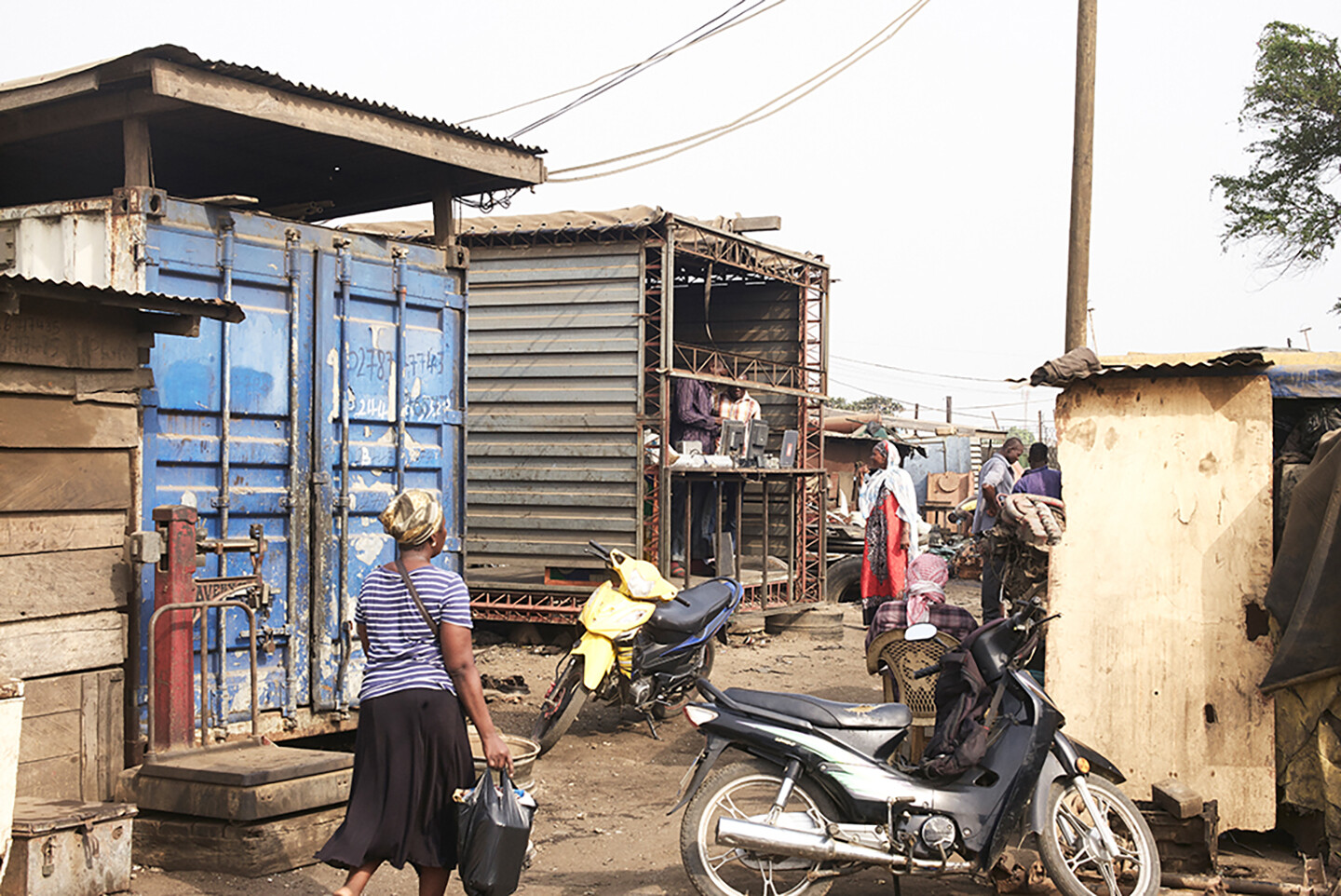

DK Osseo-Asare and Yasmine Abbas, Agbogbloshie Makerspace Platform (AMP), Accra, Ghana, 2016. Photo: Julien Lanoo.
III. Maker Culture and the New Impossibility of Pollution
The recent Maker Culture movement offers a particularly legible demonstration of how pollution becomes recast as non-pollution—an operation which is aesthetic, ideological, and economic. The mercurial rise of Maker Culture, first in Silicon Valley and then throughout the US circa 2008, was paralleled only by the contemporaneous explosion of Maker Spaces throughout much of Africa. Indeed, Maker Culture is not something that appeared in the United States and then migrated to Africa. Rather, Maker Culture represents an economic relationship between these two geographic entities (the movement’s spread to other parts of the world notwithstanding). During the past decade, the countless Maker Spaces that have sprung up in Africa have mostly been concentrated in the highly developed coastal cities of West, East, and South Africa, especially in areas with robust Anglophone universities, such as in Ghana, Nigeria, Kenya, and South Africa, but also in countries with strong Francophone universities. Proponents of Makerism in both the US and Africa tout methods of bricolage. However, in the US, this refers more to a mode of playful experimentation undertaken with the aid of milling machines and 3D laser printers, whereas in Africa “bricolage” resurrects the sense imparted by designers like Friedman, insofar as it often involves the reuse of industrial and consumer waste.
In the case of Agbogbloshie Makerspace Platform (AMP), founded by two Boston-trained architects, the relationship between Maker Culture and pollution is made explicit, as their operation is sited at Accra’s notorious international e-waste dump, Agbogbloshie.18 AMP’s co-founders see design as a way of restoring dignity to a part of the city that has been the target of much negative attention, due to extensive press coverage and blogging related to the issue of international e-waste.19 AMP draws on the existing practices of e-recycling that have long formed the basis of Agbobbloshie’s economy and hones these practices through the inculcation of new skills and knowledge in design, material science, and construction. In this sense, the endeavor is a laudable one. Nonetheless, processes of e-recycling at Agbogbloshie involve burning off plastic encasements and circuit boards, which emits highly toxic fumes, then sorting through the remaining metals and components for resale. Despite the persistent toxicity of the processes involved, AMP’s stated ambition is to “move beyond the notion of ‘e-waste.’”20 The virtuosity of design and aesthetic representation (as showcased on AMP’s website) make the claim that the highly toxic effects of e-waste dumping and the still-more toxic processes involved in e-recycling are to be overcome through aesthetic bricolage as a technique of onto-semiotic transformation.21
This transformation depends on a difference of place and context, a difference that has as its premise the longtime hording of technical knowledge (through intellectual property law and other forms of technological secrecy) that leads to the technological apartheids of neo-colonial economic systems. It must be said that many proponents of Maker Culture (including AMP’s founders) explicitly resist the institution of intellectual property by emphasizing open-source platforms for sharing knowledge, thereby taking aim at one of the underlying causes of global economic disparities. At the same time, however, Maker Culture is firmly rooted at the chiasmus where an excess of the United States’ technological property intersects with Africa’s technological poverty. It requires Africa’s hunger for technological investment and high-tech employment. This peculiar symbiosis between open-source technology and technological apartheid appears less paradoxical when understood through Douglas’s notion of pollution. The re-emplacement of what is out of place requires a stark differential between excess and dearth, such that pollution can be onto-semiotically re-evaluated to the point that it becomes not a liability but an asset.
If onto-semiotic instability is innate to a languaged world, this instability nonetheless acquires far greater powers when it operates across the stark techno-material differentials inherent to neo-colonial geography. Indeed, the power of onto-semiotic instability to magically reimagine austerity as prosperity and pollution as non-pollution prompts a reconsideration of Giorgio Agamben’s notion of the state of exception as an underlying premise of biopolitics, allowing us to move away from categories of sovereignty and legality and toward the onto-semiotic and technological nature of power.22 Douglas formulated her theory of pollution in response to the same contradiction that Agamben was responding to decades later: namely, the paradox of the sacredness of the prohibited object or creature.23 This ambivalence between the sacred and the sacrilegious—its onto-semiotic instability—renders a sovereign state of exception unnecessary, since the prohibited thing (whether pollution or homo sacer) always-already occupies an unstable epistemic position. Indeed, the forms of biopolitical organization that for Agamben exemplify the expanding un-exceptionality of the state of exception (namely, camps for extermination and exile) owe much to the semiotic operations through which a citizen can be rendered into a non-citizen, a human into a non-human.24
Concerning pollution, it would be easy to regard the international dumping of e-waste in Africa (and Asia) as demonstrations of the state of exception: in this case, an exception to the laws explicitly banning the international dumping of e-waste. However, the sovereign state of exception offers little by way of actual explanation concerning how northern nations are able to openly flout legal bans on dumping. What authorizes this illegal activity is neither a special power to declare states of exceptionality (even if declared more tacitly than explicitly), nor the use of fences and borders to delimit discrete extra-legal spatial zones. What authorizes the nominally illegal e-waste dump is the onto-semiotic instability of things, words, and waste in the context of staggering contextual displacement: pollution’s displacement from a context of technological excess to one of dearth. In the passage between the two, and with the help of aesthetic and semiotic re-presentation, terms and categories mutate such that no state of exception is ever necessary.
The effective powers of onto-semiotic instability in the context of global inequality can be gleaned from the origins of the international legislating of e-waste. The growing phenomenon first gained attention in 1986, after a cargo ship loaded with incinerator ash tainted by toxic metals set sail from Philadelphia, attempting to dump its contents in New Jersey. When the latter refused to take the waste, the ship, the Khian Sea, drifted from one Caribbean port to another, then to Central America, South and Southeast Asia, and finally West Africa, only to be repeatedly turned away at ports where it tried to dump its contents.25 In the course of its wanderings, the ship was renamed twice, so as to ward off suspicion at new ports of entry. Eventually, four tons of the ash were allowed to be deposited at a port in Haiti, after having been relabeled as “topsoil fertilizer.” The rebranding of the ash as “fertilizer” concealed its toxicity, but still harbored a vestige of truth, since ash can presumably fertilize certain plants even while leaching toxic metals into the soil. Semiotic categorization thus revealed certain facts about toxic waste while concealing other, more pertinent ones.
Two years later, an Italian ship carrying far more toxic waste found itself in similar circumstances, and subsequently deposited its waste—rebranded as construction materials—in a small Nigerian port town. Corruption and deception certainly played a role in this semiotic reformulation, similar to designating toxic ash as topsoil. Following the international outcry over these dumping incidents in Haiti and Nigeria, the United Nations convened the Basel Convention to outlaw the international exporting of toxic waste. Two years later, the Organization of African Unity banned the importation of toxic waste into African signatory nations under the aegis of the Bamako Convention. However, the Bamako and Basel Conventions both operated on the assumption that toxic pollution—when described in precise material terms—was a stable category, whereas the entire premise of Third-World bricolage is that anything has the potential to be refashioned into something else. The conveners thus failed to foresee how the technological divide between Africa and the global north would enable e-waste to be recast as technological charity.26
The idea that the effective powers of onto-semiotic instability are tied to global economic inequality can be used to reflect on a number of recent modes of re-emplacing things deemed out-of-place. For example, the growing formalization and privatization of domestic property in the slums of the global south, where modes of participatory census-taking and property-mapping help inscribe usufruct land rights into financializable rubrics of private property.27 With recent movements in participatory slum-upgrading, the materiality and physical organization of slums often remain largely unchanged, but become revaluated through semiotic transcriptions.
In various modes of re-formalizing so-called informality, we witness the persistence of the bricoleur. A recent techno-economic discourse affiliated with Maker Culture has helped enforce the idea of bricolage as an indigenous and ahistorical trait of Africans by inserting the approximate Swahili and Wolof terminological equivalents for bricolage into the west (respectively, jua kali and defko ak niëp).28 In these discourses, the attempted breaching of a north-south technological divide often transpires ambivalently through the figure of the bricoleur, whose need for e-waste makes them dependent on the same technological divide they attempt to elide through techno-bricolage.29
In light of the aesthetic normalization of techno-industrial recycling as a substitute for techno-industrialization in the global south, we should understand Friedman’s and Giovanelli’s 1984 project less as an “intervention on the scrap” and more as an “anticipation of the scrap”; as leading the way for the aesthetic-semiotic reformulation of both pollution and poverty in the wake of debt crises. The project envisioned the eventual impossibility of pollution—impossible obviously not because of any lack of toxic material in the world—but because pollution would henceforth no longer be strictly identifiable as pollution. There is now the likelihood that any matter-out-of-place—be it a weed, circuit board, or land held through usufruct rights—might secure a new place within a different semiotic-economic schema. Crucial to this process of translation was the figure of the Third-World bricoleur whose protean capabilities would enable and justify the perpetuation of economic instability. The bricoleur is the necessary concept enabling the onto-semiotic inversion of the conditions of economic inequality.
This project is described in the Yona Friedman dossier, AP FRIE, Bibliothèque Kandinsky, Centre Georges Pompidou, Paris.
African Maker Fairs have been sponsored largely by US technology corporations, while makerspaces have been set up often sponsored wholly or in part by U.S. corporations, such as General Electric’s “Garages” in Algiers and Lagos. There are research incubators such as Gearbox in Nairobi, funded by Autodesk and US philanthropic concerns. There are also the Fab Labs (Fabrication Laboratories) begun by MIT as global outposts but now autonomously sponsored.
Claude Lévi-Strauss, The Savage Mind (Chicago: University of Chicago Press, 1966), 17–22.
Hal Foster, “The ‘Primitive’ Unconscious of Modern Art,” October, 34 (Autumn, 1985): 63.
Derrida discusses Lévi-Strauss’s concept of bricolage in Jacques Derrida, “Structure, Sign, Play,” Writing and Difference, trans. Alan Bass (Chicago: University of Chicago Press, 1978), 285–288.
Foster, 64.
Yona Friedman, Une architecture de survie: Une Philosophie de la pauvreté (Paris : Éditions de l’éclat, 2013 {1978}), 33 and 182-183. Translation by author unless otherwise indicated.
Friedman, Une architecture de survie, 183.
Friedman, Une architecture de survie, 193.
Yona Friedman, “La Ville Totale,” with Kenzo Tange, Nicholas Negroponte, and Richard Buckminster Fuller in: 2000 24 (1971): 7, in Getty Research Institute, Yona Friedman Papers, Box 5, Folder 33: 7.
It is not clear whether Friedman had read Lévi-Strauss, although it seems likely given Friedman’s interest in anthropology, cybernetics, and bricolage. On methods of bricolage, see Lévi-Strauss, 17–22.
Lévi-Strauss, 17.
Ijlal Muzaffar, “The Periphery Within: Modern Architecture and the Making of the Third World” (Ph.D. Thesis, Massachusetts Institute of Technology, 2007).
Yona Friedman, “Weeds into Wealth,” 1983, in Getty Research Institute, Yona Friedman papers: Box 25: Folder 8. Yona Friedman, “Wasteland into Farmland,” in Getty Research Institute, Yona Friedman papers: Box 25: Folder 19.
Mary Douglas, Purity and Danger: An Analysis of Concept of Taboo and Pollution (London; New York: Routledge, 2002 {1966}).
Many scholars have considered weeds in relation to Douglas’s concept of “matter out of place.” For a discussion of some of the relevant literature, see Candice Bradley, “Keeping the Soil in Good Heart: Women, Weeders, and Ecofeminism,” in Ecofeminism: Women Culture, Nature, ed. Karen J. Warren (Bloomington; Indianapolis: Indiana University Press, 1997): 291–293. Of relevance to architectural theory, see David Gissen, Subnature: Architecture’s Other Environments (New York: Princeton Architectural Press, 2009), 150–167.
Industrial waste and discarded industrial scraps both being conceived as subsets of pollution, whether because of actual toxicity or merely because of their unwanted occupation of space. On the materiality of waste, see for example Jane Bennett, Vibrant Matter: A Political Ecology of Things (Durham, NC: Duke University Press, 2010). See also Joshua Reno, “Waste and Waste Management,” Annual Review of Anthropology, 44 (2015): 557–572.
It should be mentioned that one of AMP’s co-founders is a native Ghanaian, trained at Harvard University.
For AMP’s general concept, see ➝.
On “moving beyond a notion of e-waste,” see ➝ (emphasis added).
Jennifer Gabrys has stressed that the recycling of e-waste always entails its own “inassimilable remainders,” a residual pollution that is often omitted from accounts of recycling promulgated in environmental discourses. See Gabrys, Digital Rubbish: A Natural History of Electronics (Ann Arbor: University of Michigan Press, 2013), 132.
Giorgio Agamben, Homo Sacer: Sovereign Power and Bare Life, trans. Daniel Heller-Roazen (Stanford: Stanford University Press, 1998), Parts 2 & 3.
Agamben, Part 1.
To demonstrate what I mean, I would point out that the systematic extermination of Europe’s Jewry—the arch-example Agamben offers of a “state of exception”—did not constitute an exception to the legal framework that prohibited murder. Rather, as is well known, this extermination required the semiotic rendition of human citizens into non-human non-citizens, a task carried out by explicit propaganda but also by more subtle discursive and aesthetic formulations.
“After 2 Years, Ship Dumps Toxic Ash” New York Times, November 28, 1988.
Josh Lepawsky analyzes the geographic assumptions and inequalities underlying the Basel Convention in Lepawsky, “Are We Living in a Post-Basel World?,” Area 47, 1 (2015): 7–15.
See for example the methods of Slum Dwellers’ International (SDI) ➝. For a critique of privatization of favela usufruct property, see Timothy Mitchell, “The Work of Economics: How a Discipline Makes Its World,” European Journal of Sociology / Archives Européennes De Sociologie / Europäisches Archiv Für Soziologie 46, no. 2 (2005): 297–320.
One of the most symptomatic examples of the rising usage of “jua kali” in reference to high-tech culture appears in Steve Daniels’ codification and mapping of Nairobi’s repair shops in Making Do: Innovation in Kenya’s Informal Economy (self- published: 2010).
One example of the celebration of e-waste in African Maker Culture is Take Kodjo Afate Gnikou’s 3D printer, which he fabricated at Woe Lab. Gniko, from Togo, garnered acclaim in a recent Maker Faire in Africa for having fabricated a 3D printer almost exclusively from salvaged waste (with some remaining parts funded by Kickstarter) ➝.
Structural Instability is a collaboration between e-flux Architecture and PennDesign.
